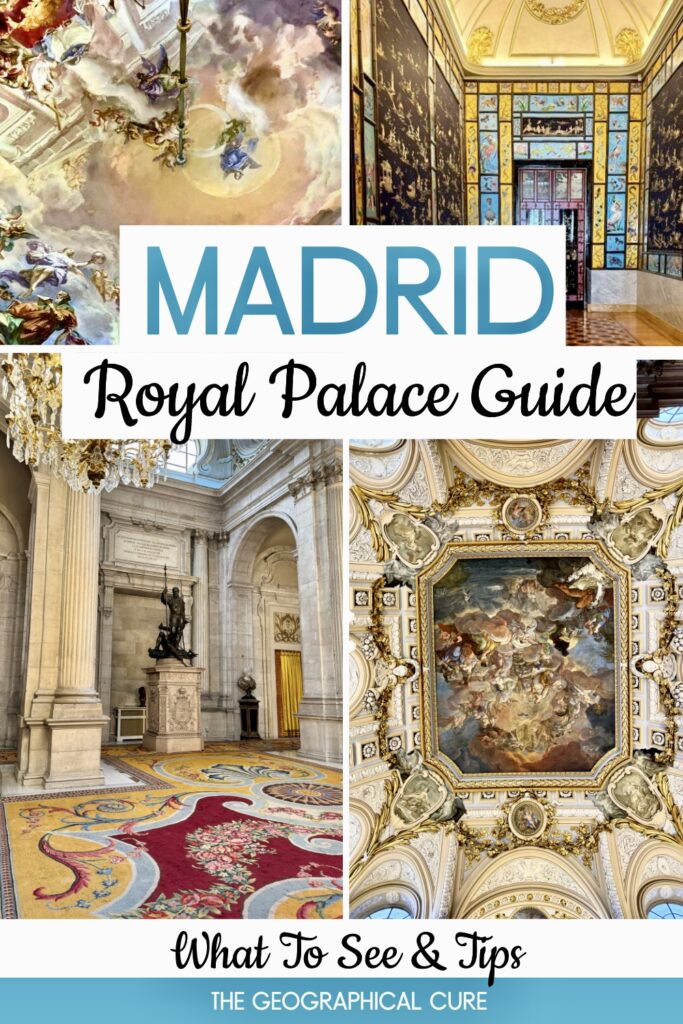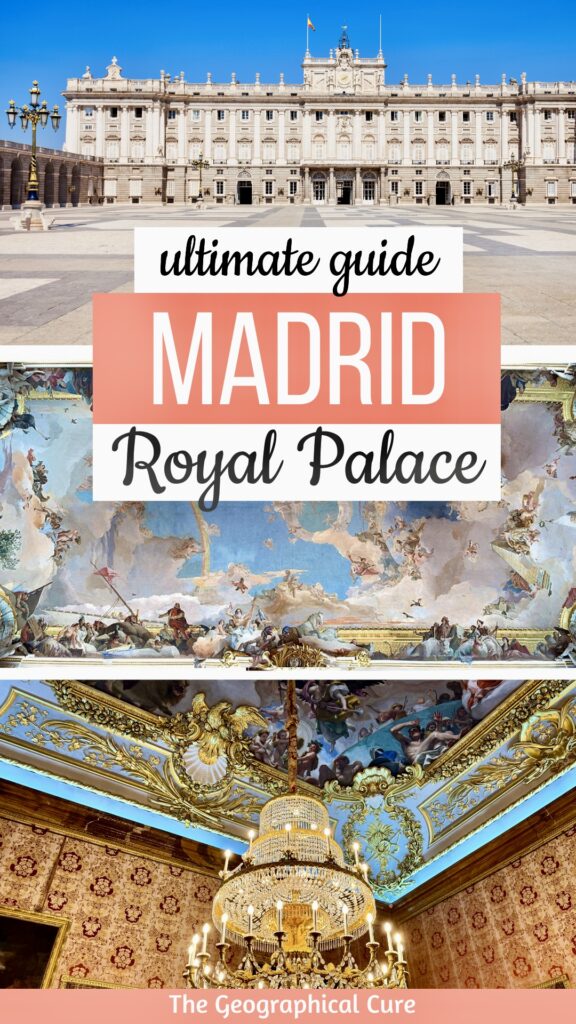Planning a visit to Madrid’s Royal Palace? I’m not that much of a palace person, but it is dressed to impress.
The interiors are nearly as sumptuous as Versailles and Schönbrunn. And almost all the 18th century Baroque and Rococo decor and furnishings are original.
On top of that, there’s some artworks by Tiepolo and Goya. And acres of marble, gold gilding, porcelain, and crystal chandeliers.
So, you’ll get an up close glimpse of the luxe lifestyle of Spanish royalty.
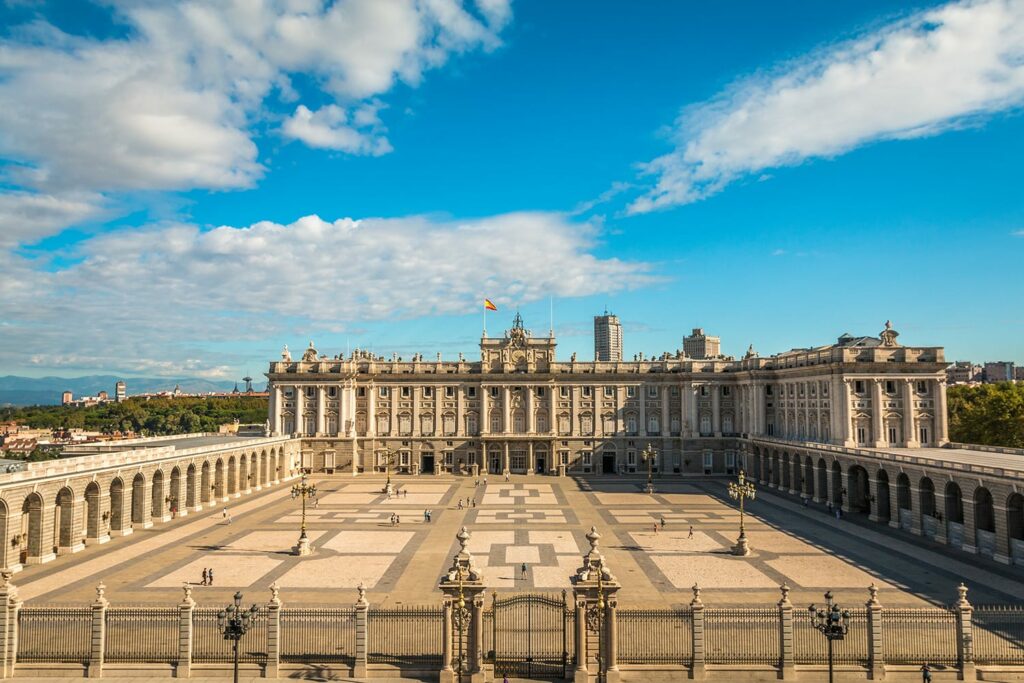
The palace is the product of the Bourbon monarchs, who came from France when the Hapsburg line died out. In building the palace, they sought to raise Spain up in Europe’s cultural hierarchy.
It’s been Madrid’s center of power since the 9th century, morphing from a Moorish castle to a Christian fortress to a Renaissance style palace.
The palace was formerly the home of the Spanish monarchs. But, today, the ceremonial heads of state don’t live there. It’s just used for special occasions.
In front of the palace stands the dashing equestrian statue of King Philip IV. It was sculpted by the Italian artist Pietro Tacca in the 17th century.
He used a design by the Spanish painter Velázquez. It’s one of the first successful attempts to cast a rearing horse and rider in bronze.
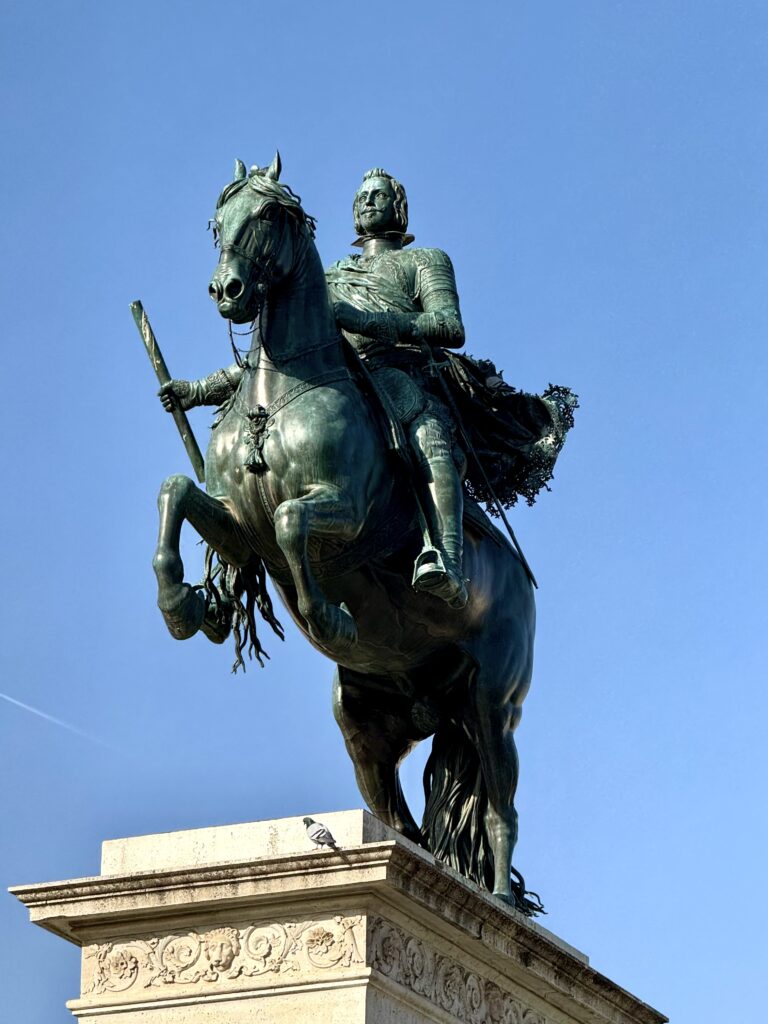
From the entrance in front of the cathedral, you step into a vast courtyard.
From here, you’ll have a beautiful view of Almudena Cathedral and the surrounding park. And this is where the Changing of the Guard takes place at noon on the first Wednesday of each month.
At the back, a grand staircase leads you up to the royal apartments.
The palace is ridiculously oversized. The actual number of rooms seems to be a mystery. But my guide gave the number 3,481, spread out over 8 floors.
You can take photos in the first two halls. But after that, photos are prohibited.
I don’t really see why this rule is in place. After all, the monarchs don’t live there, obviating any security reason. And it was rather annoying to hear shouts of “no foto” so frequently during the visit.
In any event, in this guide to the Royal Palace, I take you on a tour of the palace. Bear with me, I have very few photos and some stock photos.
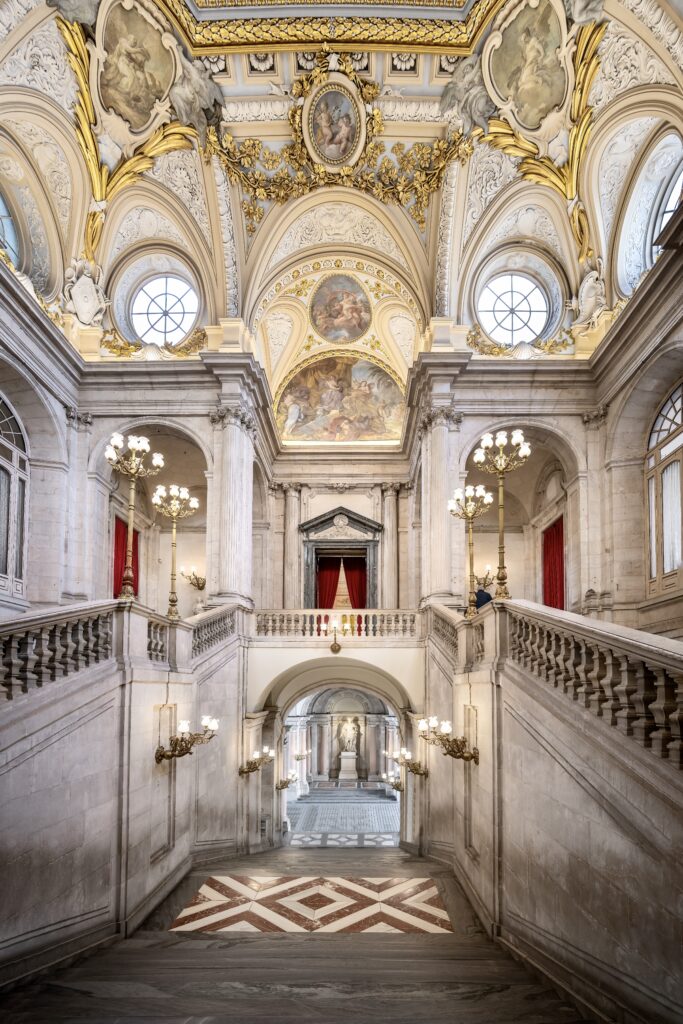
Tickets & Tours
I highly recommend pre-booking a skip the line ticket in advance. I went first thing in the morning when it opened at 10:00 am. Later in the day (in March), I saw a wickedly long line.
I also suggest booking a guided tour. A tour guide will make the palace come alive and give you anecdotes about the royal family or the artworks.
For example, I learned that Queen Maria Louisa, wife of Charles IV and the real power behind the throne, had 24 pregnancies and lost all her teeth. I also learned the that palace has a “Phantom Room” where the ghost of King Felipe V haunts the palace.
A live guide also means you don’t have to fuss with an audio guide, which I sometimes find dampens the actual “experience” of the site.
You can also book a longer 5 hour tour or a private tour that includes both the Royal Palace and the Prado Museum.
Guide To Madrid’s Royal Palace: What To See
On a visit, you’ll follow a simple one way circuit, on a single floor, that takes you to more than 20 rooms.
Palace Facade
The exterior facade is made of white stone and granite from the Sierra de Guadarrama.
It has a stately French-Italian Baroque style that was extremely popular in the 18th century.
Corinthian columns and pilasters cover the structure, adding a rhythmic elegance to its grand expanse. A balustrade roofline gives it a Neoclassical touch.
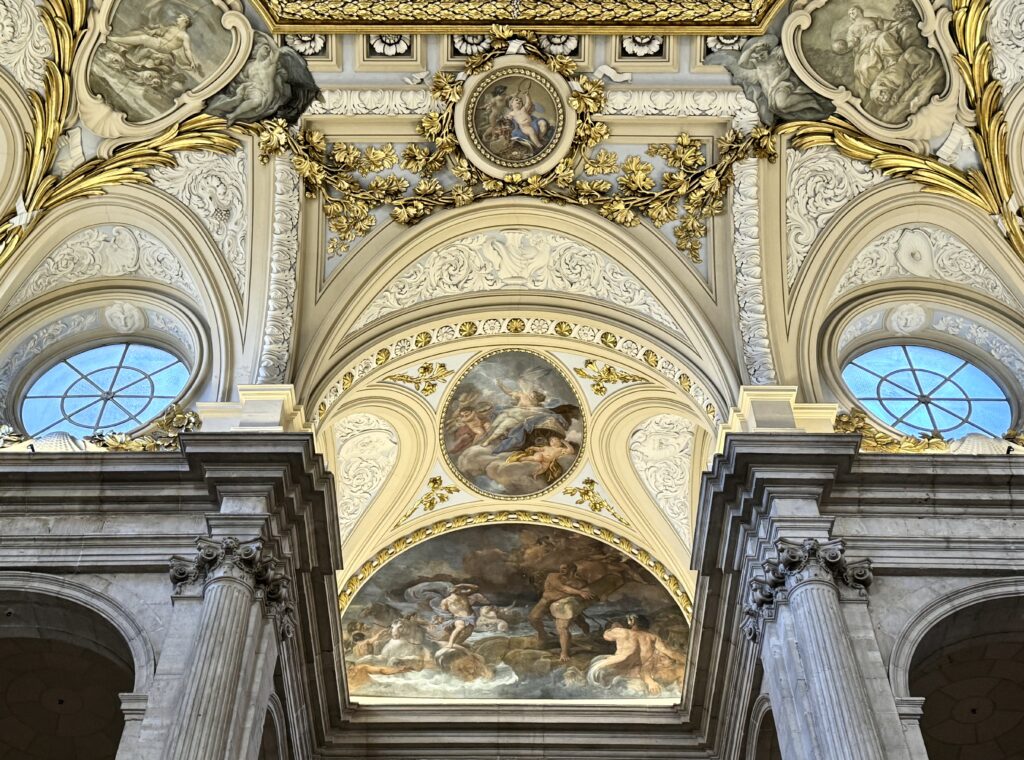
Lobby & Grand Staircase
The lobby is huge. In the old days, this is where carriages dropped off distinguished guests.
You’ll see a statue of Charles III as Caesar by Ramón Barba. Charles III was the man responsible for the lavish rooms you will see. Though he’s toga clad, to me, he appears to be channeling Napoleon.
Overhead is a frothy fresco. Allegories of the Virtues are perched on a mountain of clouds. It’s painted by Corrado Giaquinto and is a masterpiece of Baroque art.
The grand staircase has 330 shallow steps and is made of Toledo marble. Built between 1738-64, it was designed by Francesco Sabatini for King Philip V.
Once you reach the top, you’ll see a white marble statue of Philip V, who began the Bourbon dynasty in Spain.
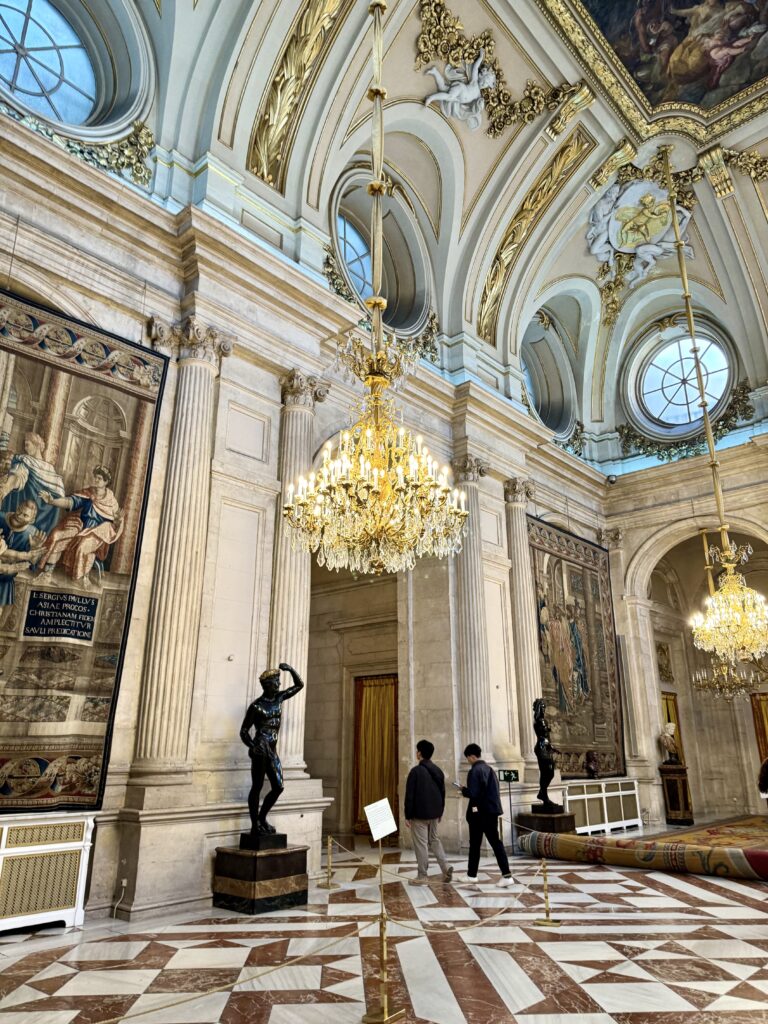
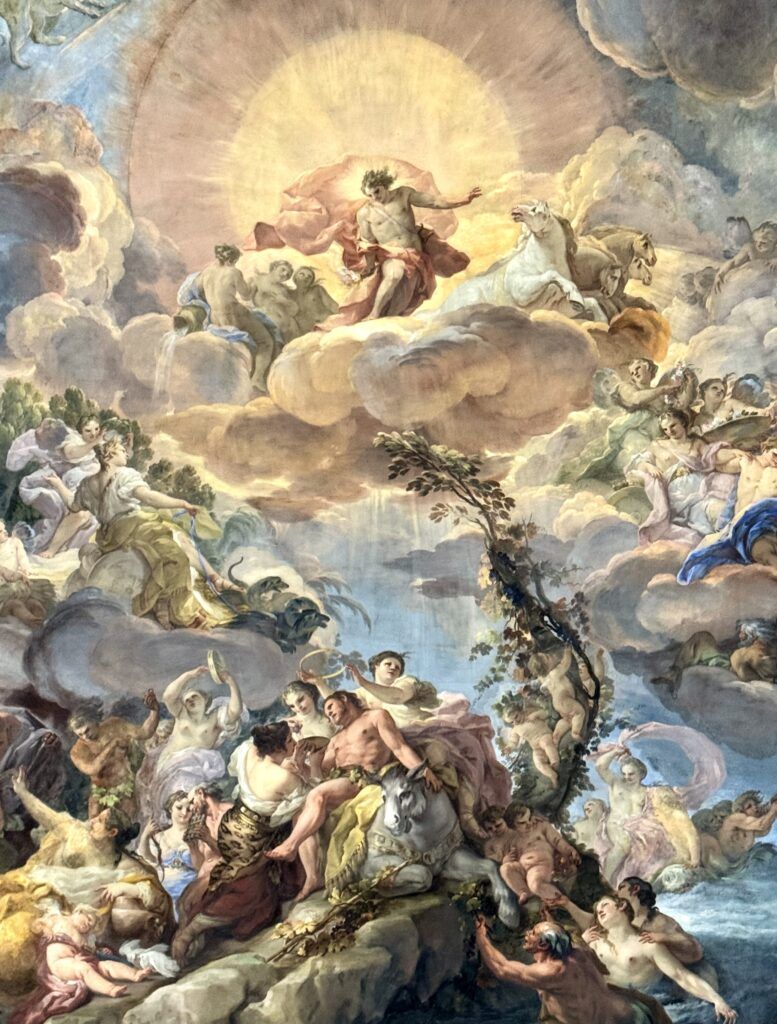
Hall of Halberdiers
The first room you enter is the Hall of Halberdiers, the room of the Royal Guard. The man over the fireplace is Charles III.
He also appears in the Tiepolo fresco above as the legendary hero Aenaes. The theme of the fresco is Vulcan forging Aeneas’ armor, a nod to the name of the room.
The tapestries were woven at the Royal Tipety Manufactory in 1756. They depict biblical scenes of Jacob, David, and Solomon, based on cartoons by Corrado Giaquinto.
There’s also a giant portrait depicting the family of the King Juan Carlos I. He assumed the monarchy in the 1970s after Franco’s brutal regime ended.
Though Franco picked him as his successor, the king surprised everyone by opting for democracy. He thus avoided being tagged with the nickname “Juan the Brief.”
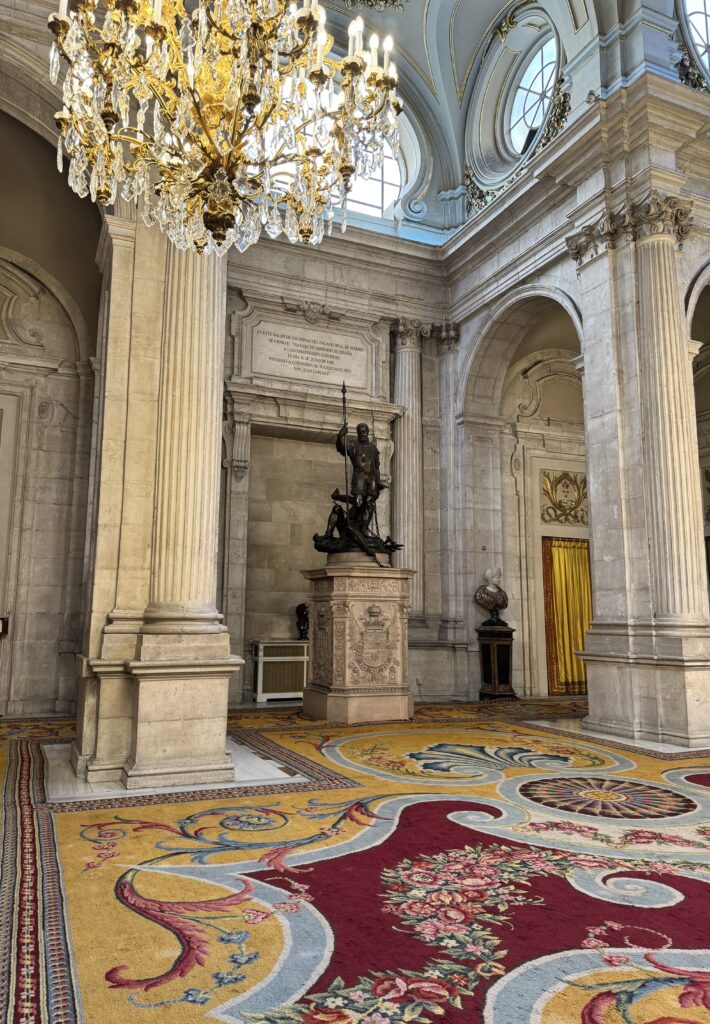
Hall of the Columns
The next room is the Hall of Columns. In Charles III’s day, this was the ballroom and the dining room.
The room’s tapestries were woven in Belgium in the 17th century based on cartoons by the Italian Renaissance artist Raphael.
The ceiling frescos show Apollo driving a chariot and Bacchus up to his usual revelry.
This hall was where Franco once laid in state. He was initially buried in the Valley of the Fallen. But he was exhumed in the dead of night and transferred to a common cemetery.
This room is also where Spain formally joined the European Union n 1985.
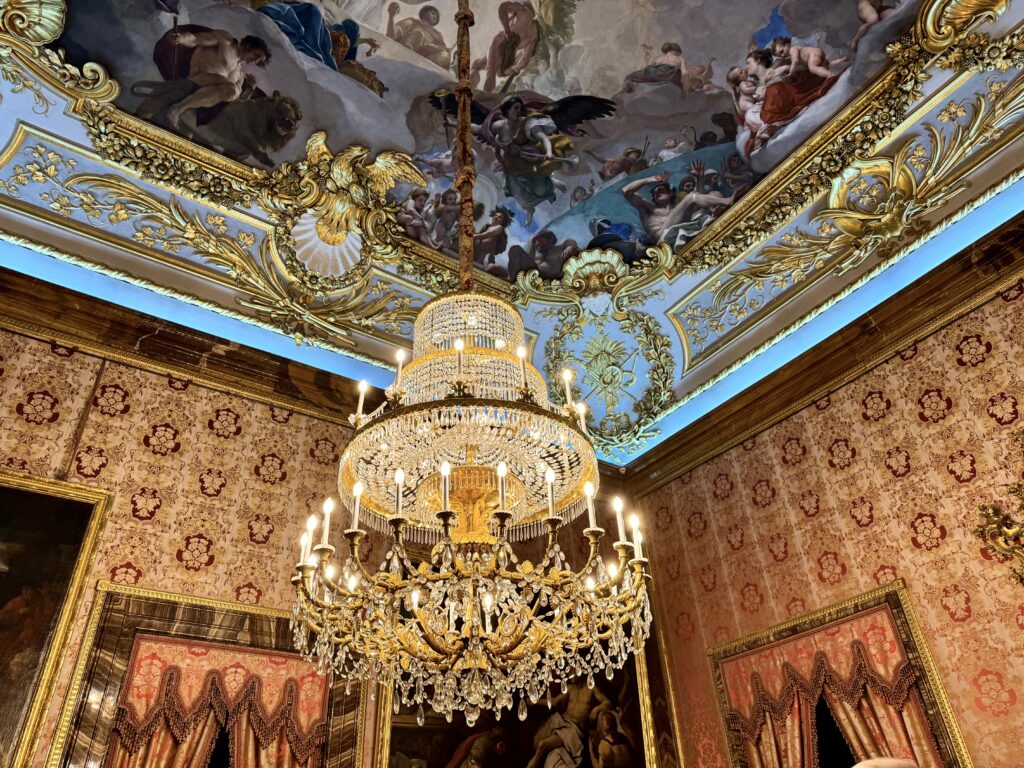
Anteroom of Charles III
This opulent room was Charles III’s dining room. The gilded decor you see here is bronze with gold leaf.
Anton Raphael Mengs painted the ceiling fresco and it depicts the Apotheosis of Hercules.
There are two superb Goya portraits from 1799 of Charles IV and Maria Luisa of Parma. These are the best paintings in the museum.
Copies of the portraits now hang in the Prado Museum. This is also the room where Velazquez’ famous Las Meninas once hung.
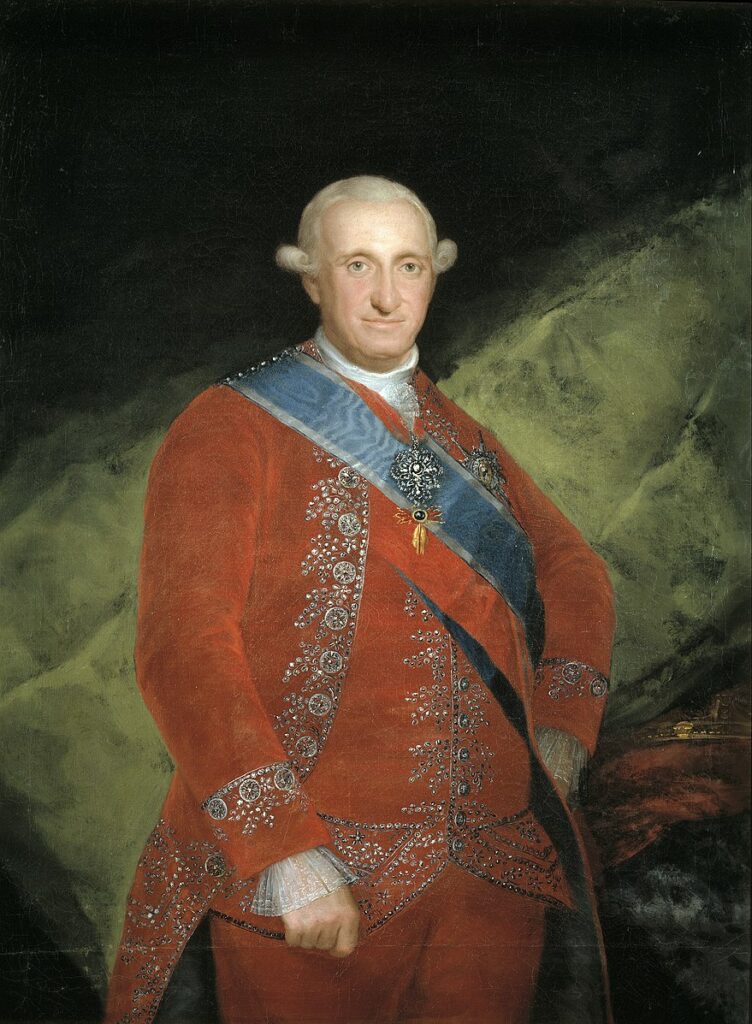
Gasparini Room
Gasp! The Gasparini Room was the king’s dressing room, where he underwent the daily ritual of being dressed in front of his courtiers.
It’s one of the most over-the-top confections in the palace. It’s a Rococo fantasia, with a gold and green design.
There are swirling inlaid marble floors, silver-threaded tapestries, silk-embroidered walls, and furnishings crafted by master European artisans. Swirling filigree and floral designs cover every inch of the walls.
On the ceiling is Mengs’ The Apotheosis of Trajan. On the walls are magnificent mirrors, candelabra, and a portrait of Charles IV by Goya.
Charles III Salon
This was Charles III’s grand bedroom, though it’s now furnished as a sitting room. The king died here in his bed in 1788.
The grand chandelier is in the shape of a fleur-de-lis topped with a Spanish crown. There’s a portrait of Charles III on the wall and a fresco overhead showing him establishing a religious order of monks.
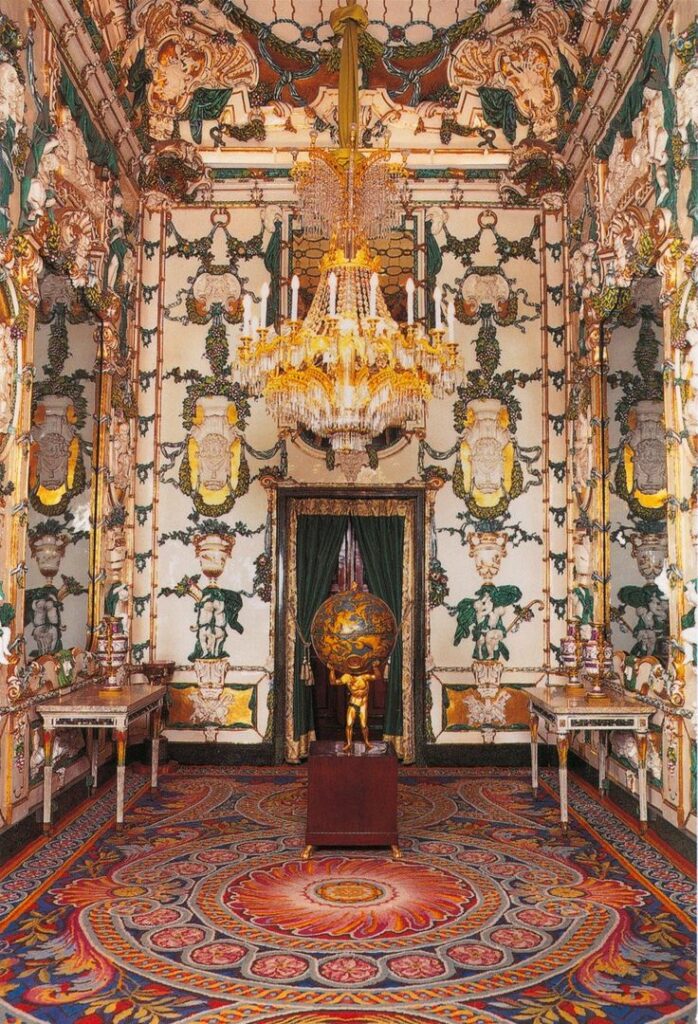
Porcelain Room
This was one of my favorite rooms in the palace.
It’s a tiny but lavish room with green, white, and gold porcelain everywhere in the shape of garlands, vines, vases, babies and mythological figures. The real theme is Bacchus.
The clock in the center shows Atlas holding the world on his shoulders.
This was where the men smoked, while the ladies ate bonbons in the adjoining Yellow Room.
Gala Dining Room
The dining room may be the most lavish room in the palace.
Balls were often held here, hence the parquet dancing floor. The dining table is the size of a bowling lane.
25 chandeliers illuminate the table. It’s used up to 12 times a year to entertain visiting dignitaries.
The room is lined with golden vases from China and fine Flemish tapestries. The chairs of the king and queen are in the center and slightly pulled out, so you’ll know it’s them.
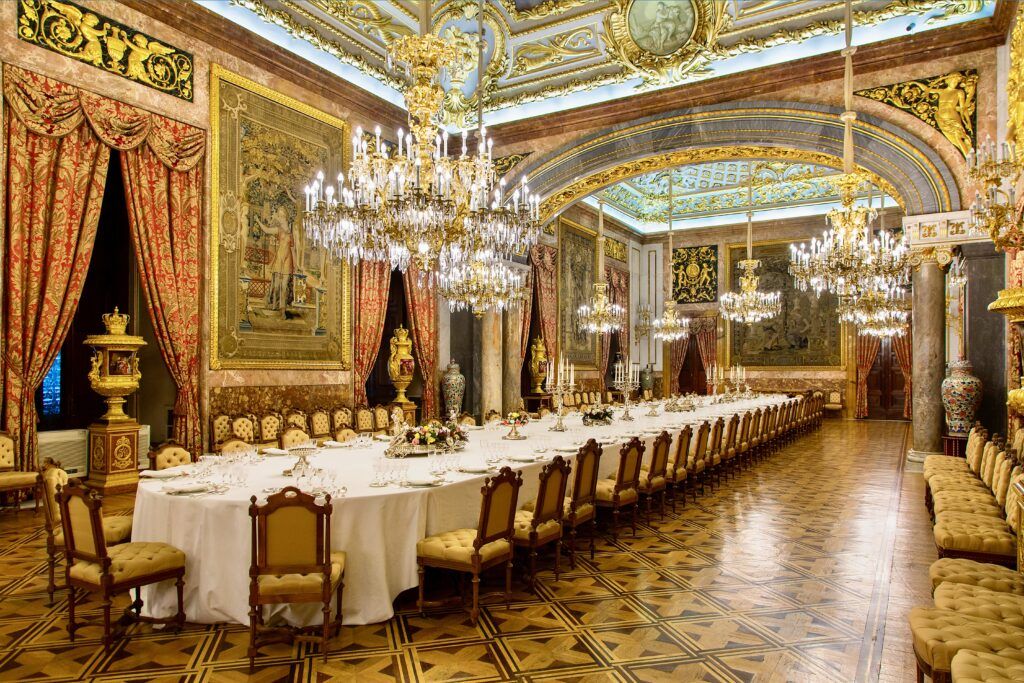
In the ceiling fresco, Christopher Columbus kneels before the catholic monarchs — Ferdinand and Isabella, presenting his exotic souvenirs.
On special occasions, pieces from the Silver Room and the Crystal Room are used. The oldest porcelain pieces have pictures of Granada and Cordoba.
Royal Chapel
The Royal Chapel is Neoclassical in style and gleaming with gilt.
This huge domed room is best known as the place for royal funerals. When a royal dies, the coffin lies in state here before making the trip to El Escorial to join the rest of the gang.
The chapel is now used for concerts. The dome sports a beautiful fresco of the Coronation of Mary by Giaquinto.
Stradivarius Room
This room contains a rare and unusual collection of stringed instruments. It boasts the world’s best collection of Stradivarius violins and the only matching quartet.
Today, these violins sell for up to $20 million apiece. They royal family’s are heavily guarded and never fly on the same plane.
Crown Room
This room holds the instruments of power. It’s sort of a “crown jewels” room.
You can see the scepter of Charles II, the gold crown of Charles III, a golden necklace of the Order of the Golden Fleece, and lion-footed former throne.
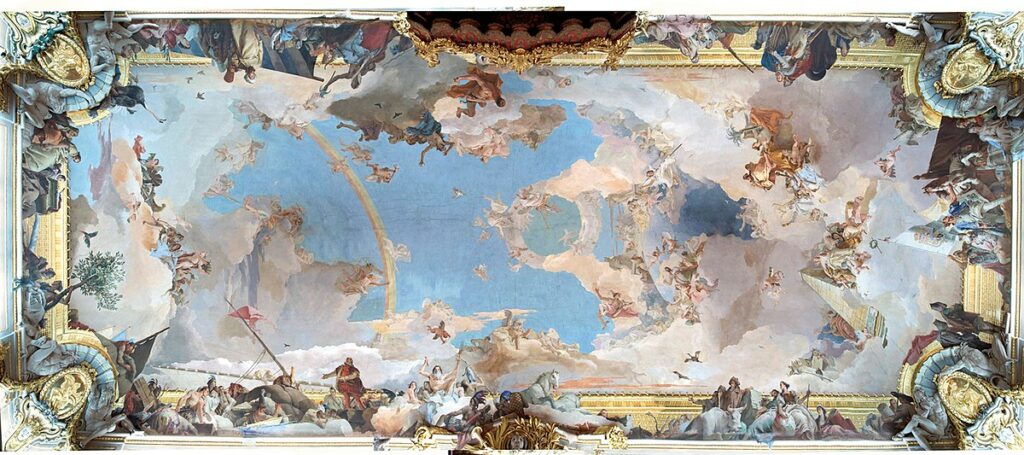
Throne Room
The sumptuous Throne Room is the most important room in the palace and the grand finale of your visit.
It’s crowned with another Tiepolo ceiling fresco, the illusionistic Apostheosis of the Spanish Monarchs. It’s one of the artist’s last great works.
Greek gods look down from the sky. Figures spill over the gilded frame, a technique called quadratura or di sotto in sù.
The fresco depicts the Spanish monarchy in a rather unusual way. Rather than just glorifying the king alone, the painting includes the entire royal family.
Beneath Tiepolo’s masterpiece is a room filled with Neapolitan furniture, Venetian chandeliers, and ornate clocks.
The thrones, set under a gilded canopy, are never used. They just represent the king and queen, who are only acclaimed not crowned these days.
The thrones are guarded by black marble sculptures that Velazquez brought back from Italy and four bronze lions.
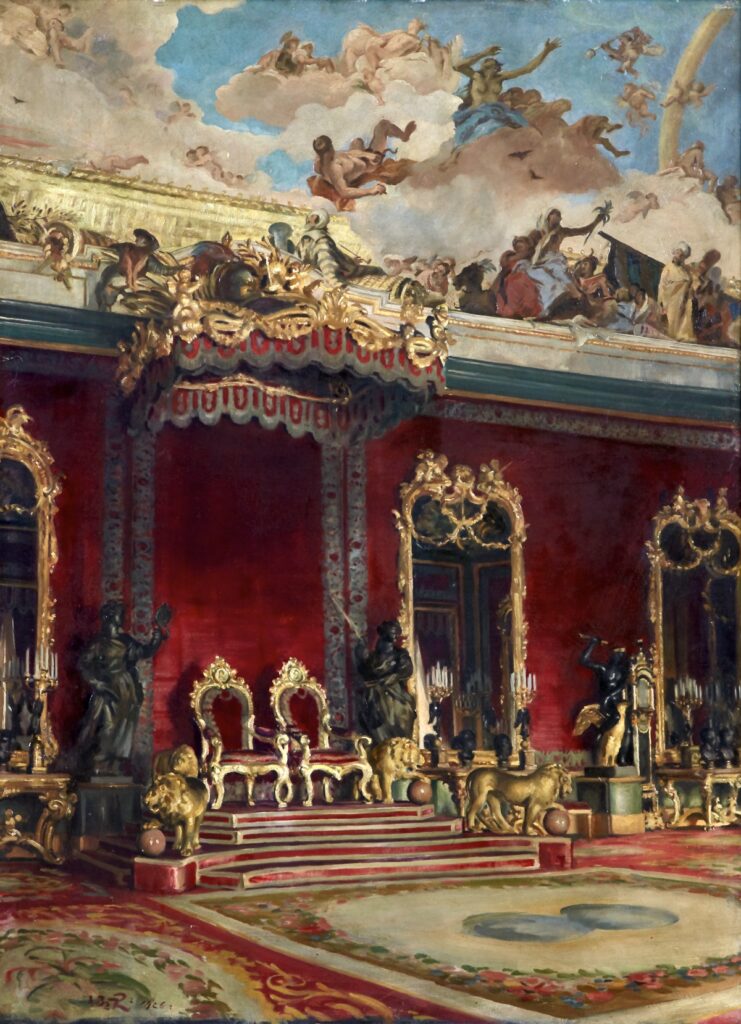
Today, this is where the king’s guests salute him before they move on to state dinners.
Royal Armory
After returning to the courtyard, you can pop into the Royal Armory. You’ll find weapons and armor galore, which were used by Spain’s greatest historical figures.
The armor wasn’t just used for battles, but for royal hunts, sporting events, and official ceremonies.
In the glass cases to the left, you’ll see the oldest pieces of the collection. In the center, there are knights in armor on horseback.
Another wall displays Charles V’s armor. There’s a mannequin of him mimicking the pose from Titian’s famous painting of him in the Prado.
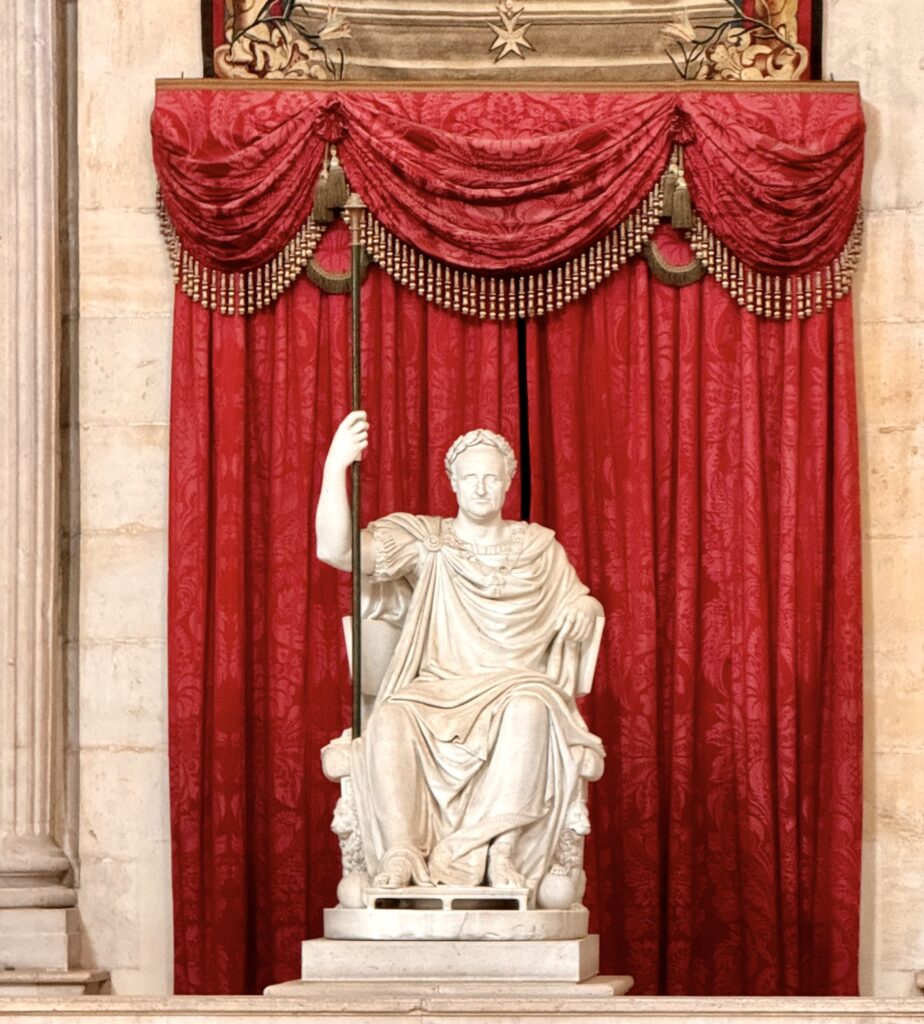
Practical Guide & Tips for the Royal Palace
Address: Calle de Bailén, s/n, Centro The entrance is at Plaza de la Armería. Be sure to get in the right line — those with tickets and those without.
Hours: October to March open Monday to Friday from 10:00 am to 6:00 pm and Sundays from 10:00 am to 4:00 pm. From April to September, open 10:00 am to 7:00 pm and on Sundays from 10:00 am to 4:00 pm.
Tickets: € 20. You can buy a ticket on the palace website or on Get Your Guide. Audio guides are also available to rent for € 3, but I’m not sure you really need them.
Pro Tips:
You’ll have to check your bag for one euro. There are short English descriptions in each room.
As a nice adjunct to the Royal Palace, afterward you can head to the recently opened Royal Collection Gallery. You’ll find more more impressive royal treasures, as well as some top level paintings.
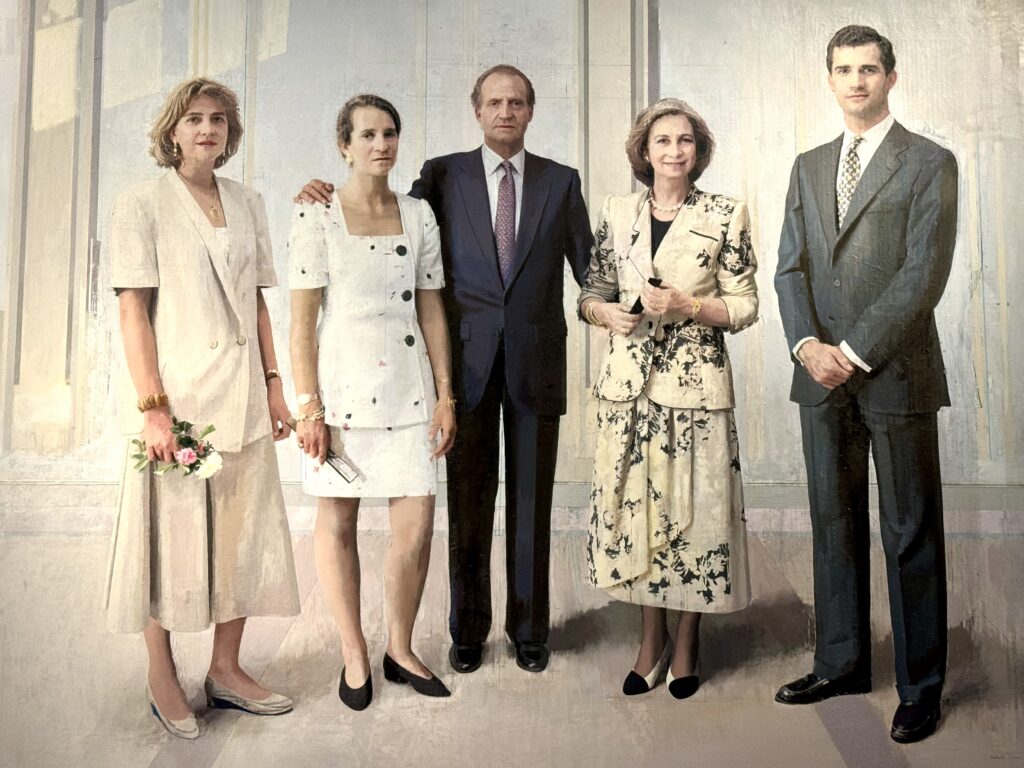
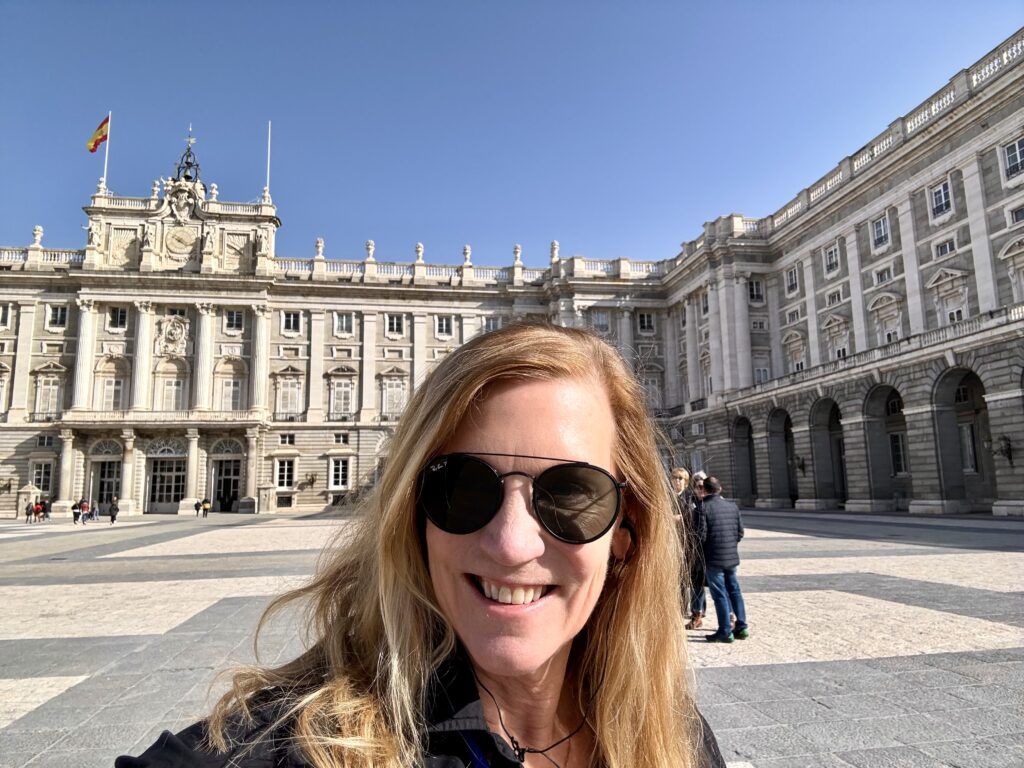
If you need a bite to eat, I would skip the palace cafeteria.
Instead, head to La Botilleria, which has a gorgeous setting. You can also go to the century-old tapas bar El Anciano Rey de los Vinos, right behind Alumudena Cathedral.
I hope you’ve enjoyed my guide to the Royal Palace. You may find these other Spain travel guides useful:
- 10 day itinerary for Andalusia
- Most Beautiful Towns in Andalusia
- 3 day itinerary for Seville
- 3 day itinerary for Barcelona
- 2 day Itinerary for Madrid
- 33 secret towns in Spain
- 10 day itinerary from Madrid to Seville
- 10 day itinerary from Barcelona to Bilbao
- 10 day itinerary for Basque Spain
- 2 day Itinerary for Bilbao
- 1 day in Toledo itinerary
Pin it for later.

